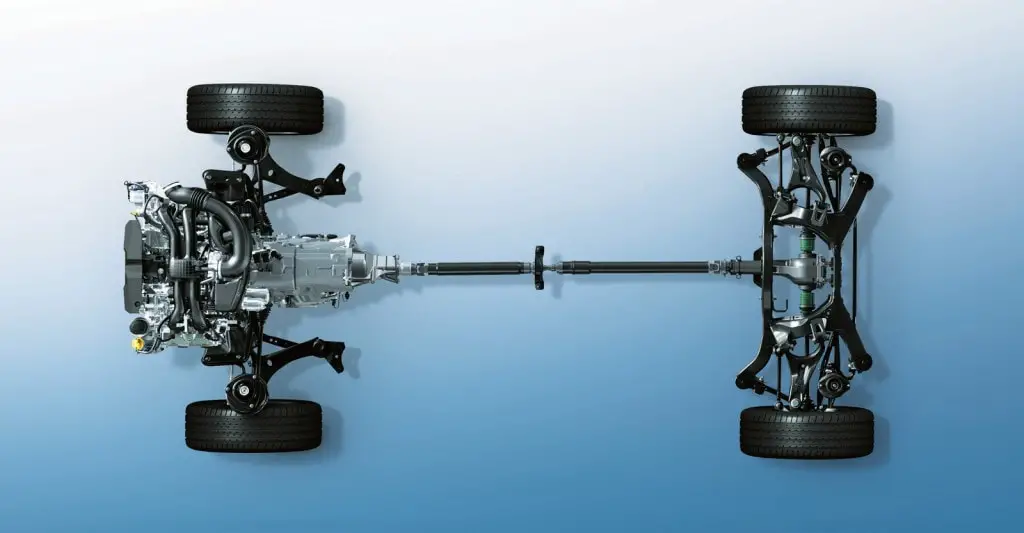Even if I personally think sedans are a less efficient use of space than their wagon or hatchback counterparts, there are still valid reasons to go with the more traditional option. However, what has been long lacking in the mainstream for this segment is a thriving selection of all-wheel drive offerings. For the last 30 years, if you, the American customers, wanted a new all-wheel drive (AWD for short) sedan at an affordable price, Subaru was your sole option.
Despite Subaru long having proven that marketing a range of AWD sedans is a solid business case in America, over the last 30 years, their competitors have hesitated in offering all-wheel drive in their mainstream sedans, instead pushing these customers to purchase an SUVs or luxury sedan instead. However, in recent years, the reliability and quality of Subaru products has been unimpressive, and with blood in the water, the competition has emerged.
Toyota, for the first time in 30 years, is offering their newest full-size Camry with all-wheel drive to American buyers. Meanwhile, Nissan is offering their mid-size Altima with the option, and Mazda their small Mazda3 with the option, with its larger stablemate, the Mazda6, set to get the option in 2022. However, if you need to buy an AWD sedan in 2021 and not spend a fortune (less than $30,000 dollars), which choices are the best ones?
Table of Contents
The best small AWD sedan: Mazda 3
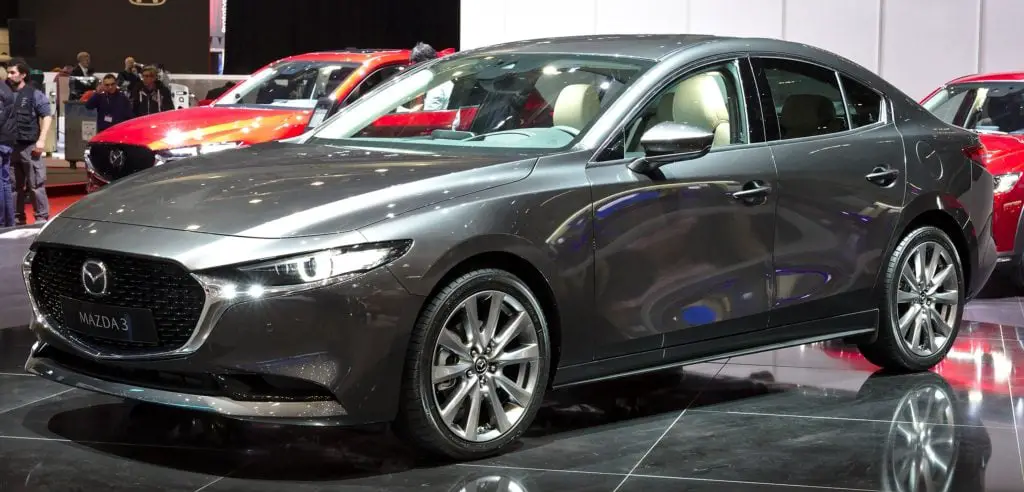
Subaru used to be the king of the AWD sedan market, but that is no longer the case. In recent years, Subaru quality has deteriorated, a decision I suspect is related to Subaru starting to manufacture North American spec cars in the U.S instead of Japan, and they were only able to continue by riding on their reputation. Mazda, on the other hand, has been repositioning themselves as a sport-oriented, entry level luxury brand. With the recent introduction of a $1,400 AWD option on their small sedan, the 3, Mazda has made its intention to de-throne the Subaru Impreza, the unchallenged king of small all wheel drive sedans, by offering Subaru their first meaningful competition in decades. But what is the challenger bringing to the table against the king?
Well, price certainly isn’t their ammunition, as the AWD option is only available on higher trim models, compared to the Impreza’s standard all-wheel drive across the range. However, that’s where the disadvantages of the Mazda 3 end. The Mazda has a number of shining points that are best in class, such as the interior. It is not an understatement to say it is nearly as good as many luxury cars. Most touchable surfaces are soft touch; hard plastics are very hard to find. Though the seats err on the side of sporty, they are comfortable and supportive.
The infotainment, while straightforward and premium feeling, is let down by the lack of a touch screen. Nonetheless, it does thankfully include Android Auto and Apple CarPlay functionality, since most people will be using their phones for navigation and music anyway. Safety is also a strong point for the Mazda, as it earns a Top Safety Pick Plus from the IIHS, which is even more strict than their usual criteria, and an area where the Mazda bests the Subaru Impreza. However, some people may find the cabin to be a bit small feeling, and rear seat room is lower than competitors like the Honda Civic. In addition, cargo space is unfortunately below average for the class, limiting the overall practicality of the Mazda.
However, where the Mazda 3 truly shines is in its driving dynamics. In all wheel drive guise, the mid-range, naturally aspirated 2.5 liter engine is adequate for the size and responsive. However, the optional turbo engine is another animal entirely. With 250hp and 320 ft/lb of torque using 93 octane, it has a lot more get up and go than the mid-range engine. Coupled with Mazda’s historically strong suit of good chassis dynamics, natural steering feel, and a firm yet compliant suspension, of the range of Mazda 3 Sedans, this one will be the most fun.
In my view though, the one to get is the mid-range, $25,000 2.5 liter engined model, which starts at about $25,000. As the Mazda 3 with the turbo engine starts at over $30,000, other cars make more sense at that price point. However, if you do choose the turbo engine, you won’t lose on fuel economy, as there is an overall 1 MPG difference between the two (28 MPG combined for the 2.5 Naturally Aspirated motor and 27 MPG combined for the turbocharged motor), though the greater expense of 93 octane premium does dampen that cost differential somewhat.
Overall though, the Mazda 3 is a great, reliable, and, imperfect commuter that makes a much more compelling sales case than the Subaru Impreza. The near premium feeling interior and excellent driving dynamics are strong points, while the slightly cramped feeling cabin and small cargo capacity are the biggest weaknesses that may be a turn off for some taller drivers accustomed to the Mazda’s more pedestrian competitors like the Honda Civic and Toyota Corolla.
The best mid-sized AWD sedan: Kia K5
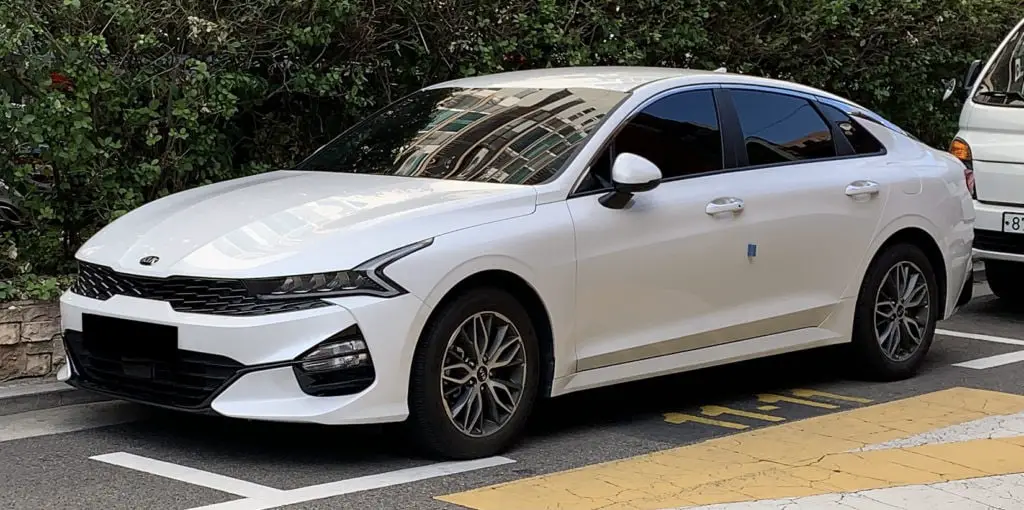
I’m really showing my age here. In the 1990s and 2000s, Kia was the butt of many jokes. The quality was bad, and the cars so cheap, that it often made people wonder if you had actually failed in life. For Kia to actually be in the same league as reliability king Toyota? In 2000, you would’ve been laughed out of the room. 10-20 years later, its a very different story indeed. Parent company Hyundai has moved upmarket and introduced a luxury brand Genesis, and Kia has sought to cast aside their food-stamp brand image with the introduction of a series of compelling products in recent years. Even if the Kias of the 1990s/2000s are casting a shadow on Kia today, don’t let the (in my view outdated) frumpy reputation of brand turn you away, as that is absolutely NOT a representation of what a Kia is in 2021
Nowhere is this more true than with the K5, Kia’s replacement for the Optima. Despite the anonymous sounding name, the exterior styling is anything but, as it is considered by many to be the best looking midsized sedan on the market. With swooping curves all around and an aggressive front fascia, it certainly looks the part of being sporty. However, if you want the all-wheel drive, that is where the sportiness stops, as all wheel drive is only available with the base 1.6 liter turbo 4 cylinder that produces 180 horsepower, which, while not impressive, isn’t terrible either. The best word to describe the driving experience of the K5 is easy. It is very much middle of the road, which is exactly what you want for everyday use, though given the styling, it is a bit of a let-down. The upside of that smaller engine is the fuel economy of the K5 with All-wheel drive, which is 28 MPG combined, just 1 MPG shy of its closest competitor, the Toyota Camry AWD.
However, there are far more strong points for the Kia. Notable is the interior, which is has comfortable seats, premium feeling materials throughout, and logically laid out controls. The infotainment is also good, with the touchscreen unit being straightforward and easy to use similar to a Samsung smartphone. The unit is equipped with Apple CarPlay and Android Auto, which, let’s be honest, is the functionality that matters most, since most people will likely use the infotainment as a means to extend the interface of their phone instead. Rear legroom is also abundant, and outward visibility is also excellent due to thinner A-pillars by 2021 standards. That doesn’t mean it is unsafe though, as the Kia K5 earned a Top Safety Pick Plus rating by the IIHS in GT-Line trim due to the optional LED headlights.
As a result, and due to it being the lowest trim available with heated seats, the $27,000 Kia K5 GT-Line AWD is the K5 to get. And if you do get it, you get one of the best factory warranties in the business, a 10 year/100,000 mile warranty, which indicates how much the company believes in the quality of their products (if they were bad, they would lose millions of dollars on repairs) and a good sign for overall reliability.
The Kia though, isn’t perfect, and the biggest cons of the K5 are the driving position, which is too tall, and rear-seat headroom, which, due to the swooping roofline, is much more form over function, and is less than the competition. Overall, the Kia K5 is a stylish, affordable, well built mid-sized sedan that beats the Camry at its own game and should provide years of reliable service.
The best used AWD sedan: 2018 Genesis G80
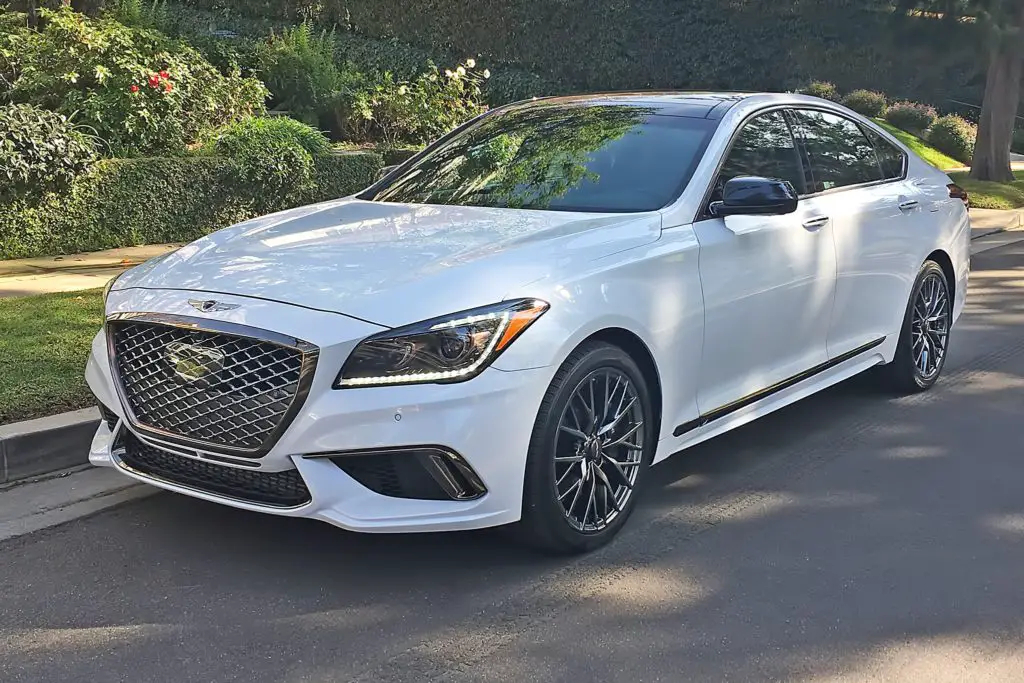
If you need an AWD sedan, and you don’t mind buying a lightly used car, you can get a much more premium product while avoiding much of the depreciation that comes in the first few years of owning a new car. Like in a previous article I wrote, The best used cars under 15000 dollars, my instinct was to recommend a Lexus GS. However, what I have realized in researching these two articles is that Lexus is no longer the top dog in the reliable luxury game, and Hyundai has surpassed them with their Genesis luxury brand.
For a reasonable, sub 30k price, the best value for money in getting an AWD sedan has to be the 2017-2018 Genesis G80. While it suffers from a very anonymous sounding name like the Kia K5 and a virtually unknown brand name, it’s hard to argue with the value proposition of getting near-Mercedes E Class luxury for new Toyota Camry money. And its not like buying a used Mercedes where the repairs alone would be enough to pay back Ivy-League student loans either, as the Genesis G80 is pretty reliable too, making it true competition for Lexus and not financial suicide like owning a European luxury car. This is aided by the fact that many of these cars are still in warranty, being newer than 5 years old and having less than 60,000 miles on them, so even if something does go wrong, it won’t hurt you.
The Genesis G80 is more than able to stand on its own merits, as there is a lot to like. Nowhere is this more true than on the inside. In the front, the seats are comfortable as is expected in the class. The infotainment is also easy to use, and the inclusion of Apple CarPlay and Android Auto means it is able to do the one thing you want it to do: act as an extension of your phone. The other buttons are laid out logically and nothing seems too out of place. In addition, rear seat legroom is incredibly abundant, as the G80 has the longest wheelbase of its class at 118.5 inches. As is typical of the class, a panoramic sunroof is available, both the front and rear seats are heated, and for the all-wheel-drive models, a heated steering wheel is standard.
However, unlike its competition, it doesn’t try to be sporty, and instead, seeks to solely do its job as a large, luxury sedan. At the sub-30k price point, the engine you will find is the base 3.8 liter V6 that produces 311 horsepower. And while it isn’t the fastest in the class, that isn’t the point. Instead, sit back, relax, and enjoy the smooth drive, as that is what the G80 does best. That long wheelbase, combined with a compliant suspension that readily absorbs bumps, contributes to a comfortable, smooth and quiet ride, and the power steering is tuned more for ease of use, not for communicative feedback.
The G80 though, is not perfect, and the most notable criticism of the G80 is the fuel economy, which comes in at a thirsty 21 MPG combined. The rear seats, strangely, cannot be folded down, which limits the overall practicality. Furthermore, if you are looking for something sporty, the G80 is not it, as the steering can be described as numb and uncommunicative. If that is a must in your luxury sedan, then a 2015 Lexus GS350 with all-wheel drive is better suited for the job. Overall though, the G80 is an affordable option for a great, comfortable, all-weather luxury car that shamelessly specializes in being luxurious without trying to be sporty at the same time like its competitors.
The classic icon : 1992-2000 Subaru WRX
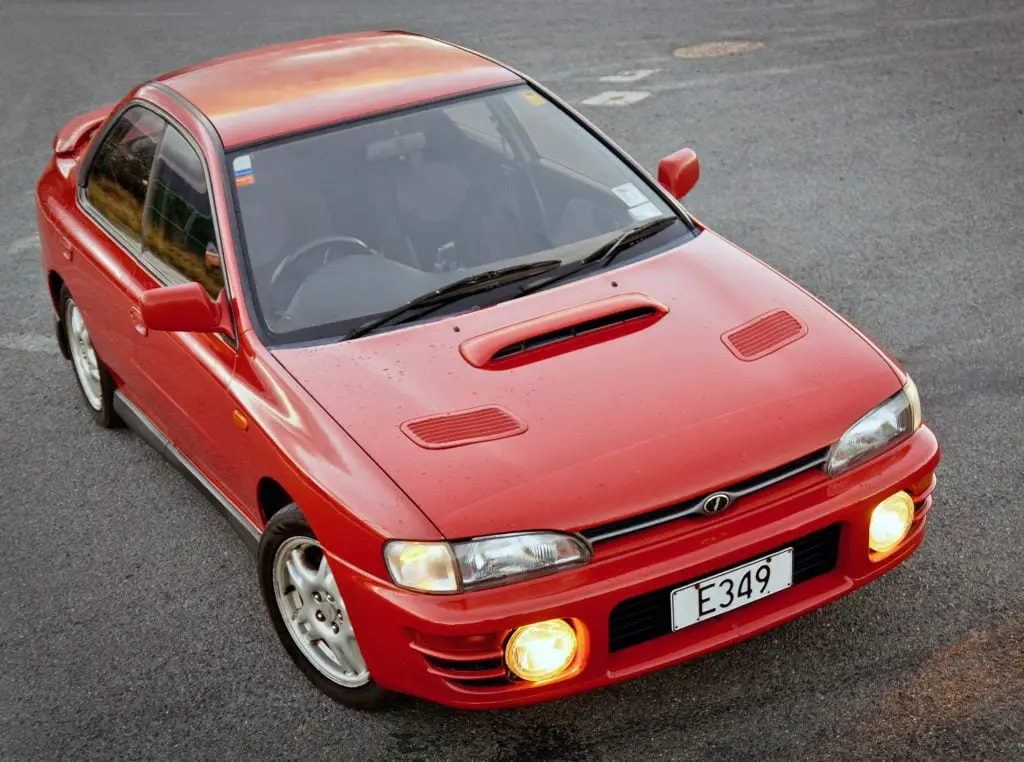
JDM heroes from the 1990s are becoming less affordable by the day, however, there are a few that have remained reasonably affordable. Among this small cohort, the one to get is the 1st generation Subaru WRX. Since this version was not sold in America, you will inevitably be buying an imported example with right hand drive, which may turn some people off, but isn’t a big deal in my opinion, especially after spending a few minutes to get used to it.
Even if Subaru in recent years has let their quality deteriorate, Subaru in the 1990s was a very different company. They were one of the first manufacturers to utilize four-wheel drive systems for their mainstream cars, and the WRX was their attempt at making something competitive in rally racing.
And that they did. With a 0-60 time of 5 seconds (which, for reference, was significantly faster than a same year Chevrolet Corvette), they would have many wins in the World Rally Championship throughout the 90s, even taking the top spot in the 1995 WRC Driver’s World Championship with Colin McRae behind the wheel.
As a usable, everyday car, 90s Japanese cars in general are known for their reliability, and the Subaru WRX is no exception. However, if something does go wrong, unlike many other imported cars, parts shouldn’t be too difficult to find locally, as Subaru did sold the base Impreza in the U.S, and the EJ family flat 4 engine was used by Subaru for over 30 years until its discontinuation earlier this year, meaning mechanics will be very familiar with it.
Strong points for the 1st gen WRX include raw, analog driving experience characterized by a power band that comes alive in the high RPMs: a sharp contrast from the low-burble, torquey, bro-vibes of the models that the U.S. got. Given that these are performance cars, inspect for prior crash damage and ensure that it was repaired properly and make sure the mechanical components are in good working order, as cars designed for this purpose are more likely to have been in a crash.
In addition, buy the most stock, rust free example you can find, because sorting out someone else’s modifications (and whether they have been done properly or not) is a very time consuming task. Given Japan has a very high smoking rate (a figure that was even higher when these cars were new), I would also advise soliciting a professional detailing company do a thorough interior clean of any classic JDM car’s interior to remove any potential buildup of toxic chemicals in the fabrics to a previous owner’s poor lifestyle decisions. Also consider replacing the cabin air filter and cleaning out the vents for the air conditioning system.
However, practically speaking, all is not perfect with the Impreza. Even in their time, trunk space was solidly average, rear seat room was cramped, and the plastics on the interior were mediocre at best, something that is even more apparent over the last 25 years. The brakes are also too small in stock form, so consider upgrading them if you plan to do a lot of spirited driving. Fuel economy is also very average by the standards of a small sport sedan, around 20 MPG US can be expected in stock form, albeit, being a turbocharged performance sedan, 91 octane or higher is a must. The frameless doors also can be a problem, as at high speeds, the windows can get “sucked out” and let wind noise into the cabin.
While classic cars may be objectively inferior to modern cars from a technological standpoint, something about these older vehicles speaks to the heart more than any new car can. And if you want a classic all-wheel drive sedan that is fun to drive and can fit the whole family, the WRX is hard to beat for 20k landed in the U.S. Overall though, it is a simple, analog, fun-to-drive car that you can enjoy without worrying about depreciation like a newer car.
